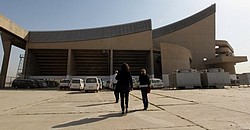
Iraq wants to restore the 'lost' building by Le Corbusier
 |
The massive concrete structure in the eastern part of the city surprisingly survived decades of war, civil strife, and sanctions that affected the country. Iraq commissioned its construction in 1957 when it was a wealthy oil state. The Baghdad hall was then just a small part of a planned Olympic village. The building was designed by Le Corbusier, who is considered one of the greatest architects of the 20th century and who was then at the height of his fame.
The revolution in 1958, which overthrew the Iraqi monarchy and resulted in the death of its main representatives, including the king, pushed the project into oblivion; it was only completed in 1982 under Saddam Hussein's rule. Thus, the hall was finished years after Le Corbusier's death in 1965 under the guidance of one of his partners, Georges-Marc Presente. He ensured strict adherence to Le Corbusier's clean, industrial, modernist principles.
Charles-Edouard Jeanneret, known as Le Corbusier, deeply engaged with the project in Baghdad and "about 500 drawings bear his personal signature," said Mina Marefat, a Washington architectural historian and expert on Le Corbusier.
According to her, the architect traveled to Baghdad in 1957 and was then "extremely disillusioned" that his project was shelved the following year. "The most surprising thing about Le Corbusier's work in Baghdad is how little attention it has received from experts," she added.
Once the hall was completed, it hosted generations of Iraqi athletes - basketball and volleyball players, gymnasts - as well as a number of international competitions. "For Iraqi sport, it is a historical legacy, a symbol," said its current director Wasfi Kinani to AFP.
But the golden age of the hall ended at the turn of the millennium. From 2003 to 2004, it was occupied by American soldiers. After their departure, sectarian violence that engulfed the country hindered opportunities for sports.
Caecilia Pieri, a researcher at the French Institute of the Near East, discovered the forgotten site in 2005 while working on her dissertation about modern architecture in Baghdad. She then decided to contact the Le Corbusier Foundation in France, made several trips to Iraq, and the result is a Franco-Iraqi project aimed at raising general awareness about this building.
A book about the Baghdad sports hall is set to be published, a colloquium will be held, and the building itself has been under renovation for a year. However, it is still far from the pure, almost ascetic vision of its creator. The seats are painted in bright colors and the ceiling over the changing rooms, which was designed to allow natural light, is blocked by a false ceiling with artificial lighting.
The English translation is powered by AI tool. Switch to Czech to view the original text source.
0 comments
add comment












